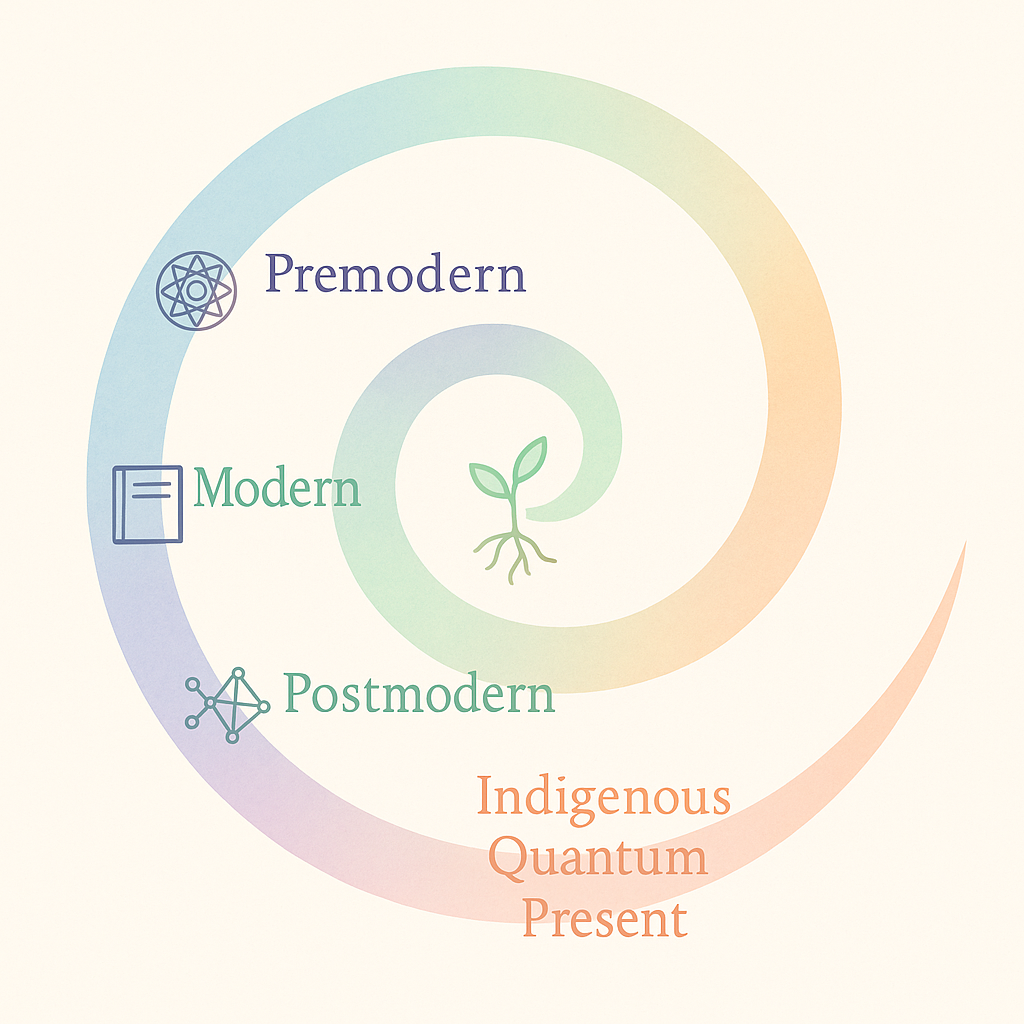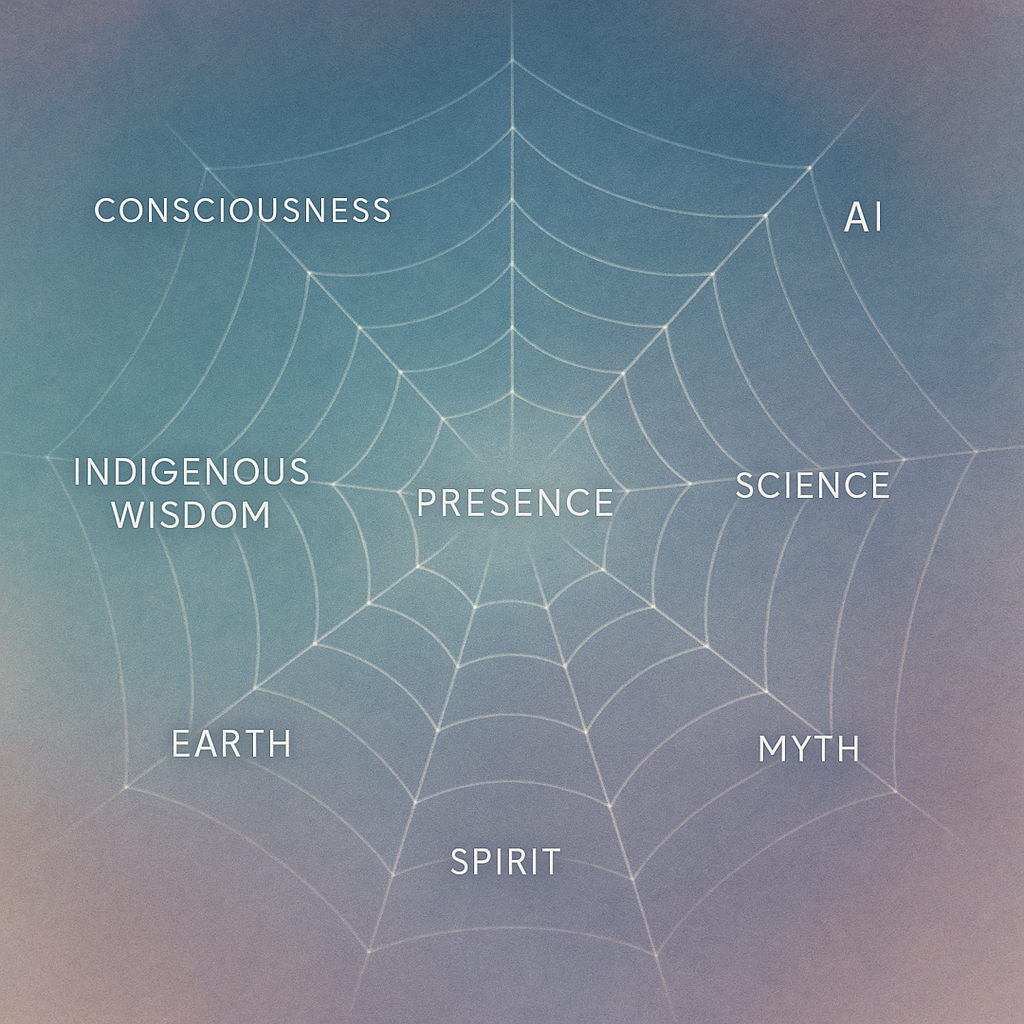Beyond Time | Returning to the Living Space of Connection
featured image: Rui Lourenço
This essay critiques the divisive structures of modern Western thought and its reliance on categorization, separation, and hierarchical knowledge. Drawing on Ken Wilber’s models while gently transcending them, it contrasts fragmented worldviews with Indigenous and quantum paradigms rooted in relationality, space, and presence.
Contemporary distinctions between inclusive Indigenous premodern worldviews and the hierarchically exclusive frameworks of Judeo-Christian Western thought are striking.
Reflecting on these differences, I often cringe at the endless academic parsing of terms—modern, premodern, postmodern, religious, philosophical, scientific, positivist, and post-positivist. Complex language like “ontological” and “epistemological” can feel alienating to everyday people, creating barriers to meaningful participation in shaping global change.
Each academic silo—psychology, sociology, anthropology, chemistry, physics, biology—fractures even further into behaviorism, cognitive psychology, psychoanalysis, Newtonian, relativistic, and quantum physics. Some distinguish worldviews as Western, Eastern, or Indigenous. Yet, no single person can truly comprehend the endless complexity that division produces. Divisibility itself alienates us from indivisibility.
While there is value in marking shifts in understanding—Ken Wilber’s “Great Nest” is one profound attempt to map the human quest for meaning—there is also wisdom in cultures that presume connection at the outset. Indigenous worldviews, such as those of the Cherokee, offer a fundamentally different starting point: one that assumes connection as the basis of reality rather than arriving at it through intellectual analysis.
We often believe that greater complexity of thought will deliver liberation. But what if the solution lies not in deeper analysis but in a simple orientation shift? By changing how we live, our thoughts inevitably change. By acknowledging and participating in multidimensional reality, consciousness can reinform perception and reshape collective worldview.
Worldview orients relational reality. Premodern reality, often characterized in Western thought as early Abrahamic religion, may more accurately be seen as a vibrantly interconnected cosmos, alive with gods, spirits, and rituals honoring unity.
 Modernity, in contrast, represents the migration of separative theology into separative individuality: from the Great Separate God to the Great Separate Man. Western religion was never truly interconnected; it was painfully separative.
Modernity, in contrast, represents the migration of separative theology into separative individuality: from the Great Separate God to the Great Separate Man. Western religion was never truly interconnected; it was painfully separative.
We can better understand these historical shifts not through philosophical categories but through relationships with space and time. Premodern consciousness was space-based and present-focused: communal, earth-connected, and participatory. Modern consciousness is time-based: building on the past, striving toward the future, and often denying the sacred presence of the now.
This time-based orientation may underlie modernity’s obsession with death—the desperate quest for immortality rooted in denial of our inherence in the Great Spirit.
Today, quantum physics, especially when amplified by the rise of artificial intelligence, is beginning to destabilize these modern assumptions. Discoveries about interconnectedness, the illusory nature of time, and the observer-dependent reality of matter are surfacing even in popular media. Consciousness is becoming a central topic of inquiry, reshaping scientific and philosophical discourse.

Headlines asking, “Have we discovered the God particle?” or “Are we living inside the mind of God?” provoke both fascination and irony. Which God? What metaphor? How can understanding emerge if fundamental assumptions about divinity remain fragmented and conflicting?
Ken Wilber’s second-tier models attempt to transcend intellectual hierarchy, moving beyond progressive evaluation of worldviews. Yet, in my view, actual quantum change is not a result of more refined conceptual categories. It arises from a collective leap of being.
Old frameworks are not merely reinterpreted; they are transcended and set aside as partial and less relevant. True transformation comes not from reframing reality through superior analysis but by stepping into a different mode of existence that honors indivisibility, multidimensionality, and living presence.
Global change is not the product of greater complexity or fiercer competition. It is the quiet revolution of orientation — a return to indivisible life, where space and spirit co-create reality. As consciousness integrates with everyday action, the mystical becomes practical, and the new world emerges not from striving but from living differently now.






